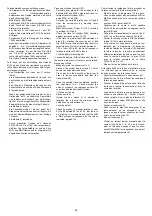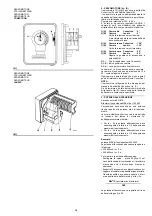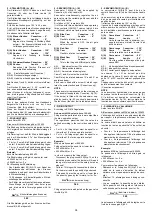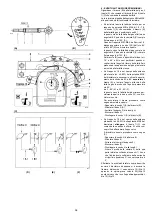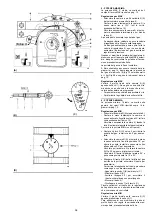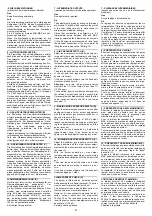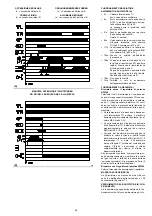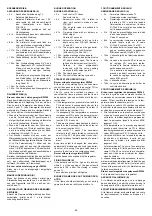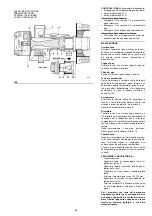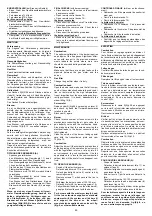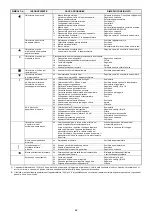
31
BRENNEREINSTELLUNG
Für die optimale Einstellung des Brenners soll-
ten die Abgase am Kesselausgang analysiert
werden.
Nacheinander einstellen:
1 - Flammkopfs
2 - Stellmotors
3 - Zündleistung
4 - Vor-Einstellungen
5 - Höchstleistung
6 - Mindestleistung
7 - Zwischenleistungen
8 - Luft-Druckwächter
9 - Gas-Höchstdruckwächter
10 - Gas-Minimaldruckwächter
1 - FLAMMKOPFS
Die feste Gaseinstellung, siehe S.18, ist schon
durchgeführt worden. Nun muß die variable
Gas- und Luft-Einstellung vorgenommen wer-
den. Diese hängt ausschliesslich von der
gewählten Höchst-und Mindestleistung des
Brenners ab.
Variable Gas-Lufteinstellung (A-B)
Sie erfolgt durch die Vor-und Rückwärtsbewe-
gung der zwei im Flammkopf angebrachten
Schieber. Die zwei vom Stellmotor 14)(A)S.10
zusammen mit der Gasdrossel und Luftklappe
gesteuerten Schieber bestimmen den Quer-
schnitt des Gas- und Luftaustritts. Wenn der
Brenner von der Höchstleistung auf die Mind-
estleistung umschaltet, verringern die beiden
Schieber den Austrittsquerschnitt und gewähr-
leisten optimale Gas-und Luftdruckwerte. Somit
wird eine hohe Verbrennungsleistung auch bei
niedrigen Durchsatzwerten gesichert. Wenn der
Brenner von der Mindest- auf die Höchstleistung
umschaltet, wird der Querschnitt durch die bei-
den Schieber vergrößert.
Die Positionierung der beiden Scheiber ist an
der Raste/Markierung am Einstellzylinder 2)(B)
in Bezug auf Auflage 10) angezeigt. Raste/
Markierung 0: Mindestöffnung; Raste/Marki-
erung 9: größte Öffnung. Die Steuereinrichtun-
gen betätigen gleichzeitig beide Schieber; sie
werden im Werk auf einen max. neunstufigen
Hub eingestellt (Verstellung des Zylinders 2)
von Wert 0 auf Wert 9, der auf die maximale
Leistungsänderung des Brenners während des
Betriebs abgestimmt ist: etwa 1:4.
Wenn das Leistungsverhältnis MIN-MAX kleiner
sein soll, müssen die Steuereinrichtungen neu
eingestellt werden, so daß der Zylinderhub 2)
auf die Positionen begrenzt ist, die den gewün-
schten Leistungswerten entsprechen und
anhand des Diagramms (A) ermittelt werden
können.
Beispiel:
wenn man mit GAS 8 P/M eine Leistung-
sänderung zwischen einem Mindestwert von
750 und einem Höchstwert von 1500 Mcal/h
anfährt, muß der Zylinder 2) von Raste 1,5 MIN
auf Raste 7,2 MAX mit einem Hub von 5,7 Ras-
ten fahren.
Wird eine Änderung am Zylinderhub 2) vorg-
enommen, so ist zu beachten, daß die Steuerp-
leuelstange 1)(B) des Mitnehmers 8) mit einem
Langloch versehen ist; wenn man das Gelenk 9)
an den Rand des Langlochs verstellt, erzielt
man eine Hubverkürzung des Zylinders 2) bis zu
4 Rasten.
BURNER CALIBRATION
The optimum calibration of the burner requires
an analysis of the flue gases at the boiler outlet
.
Adjust successively
:
1 - Combustion head
2 - Servomotor
3 - First firing output
4 - Preliminary calibrations (if required)
5 - Max. burner output
6 - Min. burner output
7 - Intermediate outputs between Min. and Max.
8 - Air pressure switch
9 - Maximum gas pressure switch
10 - Minimum gas pressure switch
1 - COMBUSTION HEAD
Fixed gas adjustments should already have
been performed as described at page 18.
The variable gas and air adjustments must now
be made.
These adjustments depend exclusively on the
MIN. and MAX. outputs at which the burner is
expected to operate.
Gas-air variable adjustment (A-B)
This adjustment consists of a forwards-back-
wards movement of two shutters mounted
inside the combustion head. These two shut-
ters, driven by the servomotor 14)(A)p.10
together with the gas butterfly valve and the air
gate valve, modify the gas and air outlet cross-
sections. When the burner changes from MAX.
to MIN. output, the two shutters reduce the out-
let cross-sections and maintain gas and air
pressures at optimal values. This ensures highly
efficient combustion even at low settings. The
opposite occurs when changing from MIN. to
MAX. outputs.
The position of the two shutters is indicated by
the notches on the graduated cylinder 2)(B) with
reference to surface 10). Notch 0: minimum
aperture; notch 9: maximum aperture. The con-
trol levers operate at the same time on both the
two shutters. The control levers are factory-cali-
brated to a maximum travel of 9 notches (move-
ment of cylinder 2) between notch 0 and notch
9), in relation to the maximum variation in output
of the burner in operation: i.e. about 1-4.
To obtain a lower MIN-MAX ratio, the lever sys-
tem must be re-calibrated so that cylinder 2)
travel takes place between the notches relating
to desired outputs, which can be read from
graph (A)
For example:
with the GAS 8 P/M model, a variation in output
between 750 MIN and 1500 MAX Mcal/h, the
cylinder 2) must move from notch 1.5 (MIN) to
notch 7.2 (MAX), representing a travel of 5.7
notches.
In order to obtain a variation in cylinder travel, it
should be borne in mind that the control con-rod
1)(B) of drive rod 8) has one slot; moving the
ball-joint 9) outwards on the slot shortens the
travel of cylinder 2) to 4 notches.
REGLAGE BRULEUR
Pour obtenir un réglage optimal du brûleur, il
faut effectuer l'analyse des gaz d'échappement
de la combustion à la sortie de la chaudière.
Régler en succession:
1 - Tête de combustion
2 - Servomoteur
3 - Puissance à l'allumage
4 - Eventuels réglages préliminaires
5 - Puissance maximum brûleur
6 - Puissance minimum brûleur
7 - Puissances intermédiaires entre les deux
8 - Pressostat air
9 - Pressostat seuil maximum du gaz
10 - Pressostat seuil minimum du gaz
1 - TETE DE COMBUSTION
Le réglage fixe du gaz a déjà été fait, voir page
18. Il est nécessaire maintenant d'effectuer le
réglage mobile qui doit être fait pour le gaz et
pour l'air. Nous rappelons que ce réglage
dépend uniquement des puissances MINI et
MAXI auxquelles on désire faire fonctionner le
brûleur.
Réglage mobile gaz-air (A-B)
Il se fait en effectuant un mouvement de l'avant
à l'arrière des deux obturateurs placés dans la
tête de combustion. Les deux obturateurs
déplacés par le servomoteur 14)(A)p.10 et par
le volet du ventilateur font varier les sections de
sortie du gaz et de l'air. Lorsque le brûleur
passe de la puissance MAXI à la puissance
MINI, les deux obturateurs réduisent les sec-
tions de sortie et maintiennent les pressions de
gaz et d'air à une valeur optimale. On obtient
ainsi un rendement de combustion élevé même
pour les faibles débits. Lorsque l'on passe de la
puissance MINI à la puissance MAXI, on a le
mouvement inverse.
Le positionnement des deux obturateurs est
indiqué par l'encoche sur le cylindre gradué
2)(B) se référant au plan 10).
Encoche 0: ouverture min.; encoche 9: ouver-
ture max. Les leviers de commande agissent
simultanément sur les deux obturateurs. Ceux-
ci sont réglés en usine pour une course maxi-
mum de 9 encoches (déplacement du cylindre
2) de l'encoche 0 à l'encoche 9 appropriée à la
variation de puissance maxi du brûleur en fonc-
tionnement: 1 - 4 environ.
Pour un rapport MIN-MAX inférieur, il est néces-
saire de retoucher les leviers de façon à ce que
la course du cylindre 2) ait lieu entre les posi-
tions correspondantes aux puissances désirées
que l'on peut établir d'après le diagramme (A).
Par exemple:
pour le GAS 8 P/M, pour une variation de puis-
sance entre 750 (MIN) et 1.500 (MAX) Mcal/h,
le cylindre 2) doit se déplacer de l'encoche 1,5
(MIN) à l'encoche 7,2 (MAX) avec une course
de 5,7 encoches.
Pour effectuer une variation de la course du
cylindre 2), il faut tenir compte du fait que la
bielle de commande 1)(B) de la barre
d'entraînement 8) dispose d'une lumière: en
déplaçant la rotule 9) vers l'extérieur de la
lumière on provoque un raccourcissement de la
course du cylindre 2) pouvant aller jusqu'à 4
encoches.

















